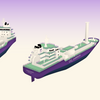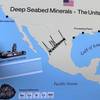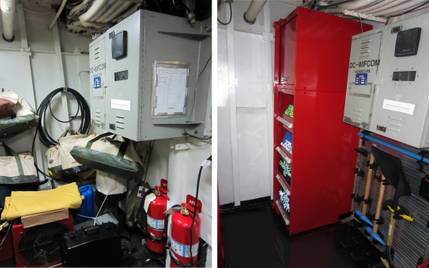Marine Training Via Simulation: As Real as it Gets
Now is the time to re-evaluate the proper role of CBT in training, and, in the process, re-visit training competency and learning proficiency support provided by all simulationtechnologies.
Realism, Why Bother?
Here is a perspective regarding realism in simulation. A simulation student was complaining to his company office that the simulator he was working on that day was not very realistic. He went on to say that the ship drove too easily, the visual picture was phony, and that the some of the bridge gear was not real equipment. The fellow from his office told him, "That's why they call it a simulator. If it were all real, they would have to call it a real-ator." Given that it is not feasible to create real-ators, only simulators, why does the maritime training industry care about simulation realism? Typically training attempts to prepare a person to apply the acquired training objectives on a real ship, and to tackle real problems in a realistic amount of time, with real consequences. Thus, if the training program can simulate realistic conditions, the objectives can be offered in a proper context, so that they best prepare the mariners for their real problems. Secondly, the recent training focus provided by the requirements of the Standards of Training and Certification of Watchkeepers (STCW-95), requiring assessed proof of competency during maritime training has required training facilities to take a new look at how tasks and training objectives are assessed and documented during simulation. It is only through control of the simulated environment, and by realistically matching the simulator performance to the training objectives that valid competency assessments may be conducted. From the pragmatic viewpoint, proper use of simulation in training, including the conscientious control of simulation environment, provides the best possible outcome for a given training investment.
Using The Category 1 Simulator in Maritime Training
The Category 1 simulator is the Full Mission Ship Simulator (FMSS) that is used by every large maritime training institution across the country. FMSS systems are used for full immersion training with maximum possible control of the simulation environment.
Typically, FMSS systems have complete bridge systems installed in a bridge mock-up, including sound and realistic visuals. This highly controlled environment is designed to provide a dynamic setting for presenting program learning objectives in a realistic shipboard context. It is most appropriate for use in acquiring proficiency in teamwork, shiphandling and integrated watchstanding tasks. The Category 1 FMSS must be equipped with high fidelity ship and topological modeling, including interactions between all simulated entities within the six-degrees of freedom of ship motions. A simulator that lacks the high fidelity technical ability to replicate discrete ship motions interacting with other vessels and the environment will subsequently lack the ability to support training objectives in areas of ship-to-ship interaction, squat, control of bank cushion, suction and objectives oriented to the control of finite lateral ship motions associated with docking and tug assist work. Thus, the FMSS must be more than a pretty picture connected to a fully outfitted bridge, equipped with gear as per the Det Norske Veritas (DNV) Class A simulated bridge standard. It must be able to support the fidelity and accuracy of close maneuvering ship behavior standards in order to be classified as NRC Category 1.
Simulators that lack the modeling fidelity and accuracy, but do have a full bridge environment and at least 240 degrees of visual field of view, are classified as Category 2, Multi-task simulators. Pragmatically, the training limitation of an FMSS system is that it can provide excessive stimulus and distractions for the mariner to adequately perform the program objective tasks. Additionally, given the variety of options and inputs available to a mariner in a FMSS system, it is difficult to assess the competency of the mariner in using specific bridge systems, as they may be actually using other systems and environmental inputs to accomplish the task. For example, assessment of proficiency in collision avoidance using radar/ARPA is difficult to assess in a FMSS, when the mariner also has access to a visual scene or a bridge team, which they may be relying on for danger bearings and identification, instead of demonstrating proficiency with the radar/ARPA unit.
Thus, the FMSS is tailored for integrated assessments and teamwork performance using complex vessel and environmental models, and is not designed for focused task proficiency training or general watchstanding team training.
Multi-Task Simulators
The Category 2, Multi-task maritime simulation trainers are designed to provide simulated training environments with accurate bridge equipment and high fidelity visual scenes without the large capital investment required for complex hydrodynamic vessel and topological modeling. The Category 2 trainer is designed to support training objectives for Bridge Resource Management, Team Dimensional Training, watchkeeping tasks, collision avoidance, communications, at-sea, deep-water maneuvering and other training that does not require highly refined ship models. These systems will typically employ simple 3 degree of freedom ship models, with little, if any, differences between the fidelity of the ownship models and the fidelity of the target ship models in the simulation.
These simple models display motions that rotate about the center of gravity, tipping center or turning center, but they do not display transverse motions representing physical displacement of the vessel's center of gravity. Essentially, these simple models can wobble the ship over one point, but they cannot slide the ship laterally away from a position, or bob it up and down as in a squat simulation. Simple three degree of freedom modeling is typically used in CBT simulators as well.
Limited Task Simulator in Maritime Training
The NRC Category 3 Limited Task trainer is a simulator designed to support training objectives for specific tasks and competencies, associated with equipment and limited underway operations that do not require a visual scene (blind bridge).
The Category 3 simulator is used for radar, Automated Radar Plotting Aid (ARPA), Electronic Chart Display Information System (ECDIS), Automated Information Systems (AIS), Vessel Traffic Systems (VTS) and chartwork/pilotage training. The key differences between the Category 3 Limited Task simulator and the Category 4 Special Task simulation system are that the Category 3 system provides separate interaction between ownships, limited bridge settings and realistic equipment, interactive maritime based communications between vessels and physical separation between bridges, along with guided instruction from a simulation trained instructor.
Category 3 simulators can employ simplistic modeling for the vessels and environment and use simulated bridge equipment rather than real hardware. The objective of the Category 3 system is to provide a limited underway setting, so that program objectives may be practiced and assessed within an appropriate context of realism. If the same objectives are assessed using the Category 4, Special Task systems, or CBT trainers, the objectives lose operational context and the resultant training and assessments can become contrived, computational routines, rather than maritime proficiency training.
The Role of the Category 4 Special Task Trainer
The evolution of higher fidelity, well crafted Computer Based Training (CBT) tools is providing an opportunity to augment the assets used in support of training objectives. CBT training aids are NRC categorized as class IV Special Task simulators, capable of simulating specific instruments or limited navigation scenarios. CBT trainers are excellent tools for isolating specific narrow tasks, within narrow contexts for illustrating parameters and situations, which may be overlooked in a more dynamic environment. In this capacity, the CBT training aid excels, and it should be embraced as such. It would be an error to replace the Limited and Full Mission simulation task objectives with CBT, due to the lack of fidelity inherent in these devices. Recently, manufacturers of CBT equipment have volunteered that their equipment may be a suitable replacement for FMSS simulation in the area of shiphandling training. Shiphandling requires fundamental control of the complex, finite, lateral ship motions and interactions between vessel and topological features. Shiphandling is a blend of science and art, and shiphandling proficiency can only be developed through applying maneuvering methods using a real ship or a simulated environment that best approaches the behavior and setting of a real ship. The appropriate simulator for shiphandling training is a Category 1 Full Mission system (FMSS). Part-task understanding and limited, focused shiphandling competencies may be practiced on a CBT trainer, but proficiency will not be achieved. Thus, the role of CBT should be to augment FMSS and Limited Task simulators, not to replace them. The CBT trainer, although a new technology, is functionally only a training tool, which has a specific role in the training cycle of providing focus on narrow tasks and objectives.
Matching Learning to Simulation
It is well understood that people learn best when many of their senses are used during a learning process. An unprepared student immersed in full mission maritime simulation can be easily overwhelmed by distractions, causing a loss of learning objective retention and gained proficiency. The simulation synergistic approach to creating an effective program requires the client to first clearly identify the outcome learning objectives and proficiencies required of their students. Next, the tasks in support of the identified objectives are listed and cross-referenced with possible learning aids and/or simulation tools. The curriculum design team then maps the learning load of the student with the progression of tasks demonstrated within the planned simulation. Adjustments are made to ensure that as much simulation and training variety is built into the program as possible, with the goal of reaching different learners from different perspectives. Lastly, the demonstration of program competencies are checked against the context they are performed in, to ensure that the measured outcomes are correct for the environment they are measured against.
Using Multiple Classes of Simulators to Support a Training Program
MITAGS provided a training solution to a major U.S. State Pilot Association that was purchasing and outfitting all of its 100 plus pilots with Portable Piloting Units (PPU). Given that the purchase of these units was a major investment, and that many of the pilots had little exposure with nautical computing tools, nor extensive experience with precise positioning systems using custom vector chart data, the standard of care for educating the pilot group was very high. To ensure that the pilots would have the highest proficiency possible, a synergistic blend of training was created that progressively encompassed the training objectives, through the use of scaled increases in classes of simulation.
The MITAGS-developed training began at their pilot station for on-site theory training and computing basics, which was reinforced in the first training simulation using their own pilot vessel as the simulation tool. Given that the pilot vessel was well known to the pilots, they encountered few distractions with the underway training environment and were able to successfully demonstrate the covered theory elements in the provided simulation. The goal of using the pilot vessel was to simply, "put the software in motion," not to provide pilots with underway, conning experience with the PPU unit. That scaled, higher level, conning task would evolve later in the training using more controllable simulation tools. Thus, the pilot vessel was being used as the simplest class of simulator, the Category 4 Special Task simulator. The objectives of this training phase could have also been accomplished using a CBT trainer in a common computer lab.
The next training phase for the pilots was to remove them from their local environment and move them to the MITAGS facility for higher-level theory classroom elements. These objective tasks were demonstrated in the MITAGS All Weather Navigation (AWN), eight ship, interactive, blind bridge simulator. This NRC classified, Category 3 Limited Task simulator placed the pilots in a scene with limited instrument, navigation and collision avoidance features. The software element of the PPU was thoroughly exercised by the pilots in the fast paced, yet forgiving, environment of the blind bridge AWN simulation. The final phase in the training cycle built on the training synergy of the previous on and off-site work by moving to the Full Mission Simulation System (FMSS) for task demonstration in NRC category II and I simulation. Category II simulation allowed the pilots to demonstrate their proficiency with the actual PPU units in controlled, Full Mission, open water pilotage scenarios, whereby category I simulation offered pilotage in restricted waters, including emergency maneuvering.
In summary, the individual pilot participating in the program experienced on and off-site training in three different simulators, with ample review of tasks and objectives during progressively difficult simulations conducted in progressively higher fidelity simulators. This synergistic scaled approach provides better student feedback on perceived gained proficiency as a result of the training, versus those who have only been exposed to traditional classroom lectures teamed with exclusive simulation in the FMSS alone. Not only are the perceived proficiencies higher, the simulation contact time increases dramatically per student, as they are not waiting to use a one-operator simulator (the FMSS) but, rather, are interactively using the category IV and III simulators in preparation for the higher fidelity and overall task load experienced in the FMSS. The future of the synergistic approach MITAGS envisions that many maritime training programs will gravitate to the use of scaled, objective based simulation in support of their programs, and endorses the classification of simulation tools as per the guidance of the National Research Council. The development of new technologies, such as CBT, is beneficial and these technologies are ready to augment the variety of training already in-place in the maritime training arena.
The future is here, and we are ready to simulate it.
by George B. Burkley, Department Head, MITAGS Applied Research Department











